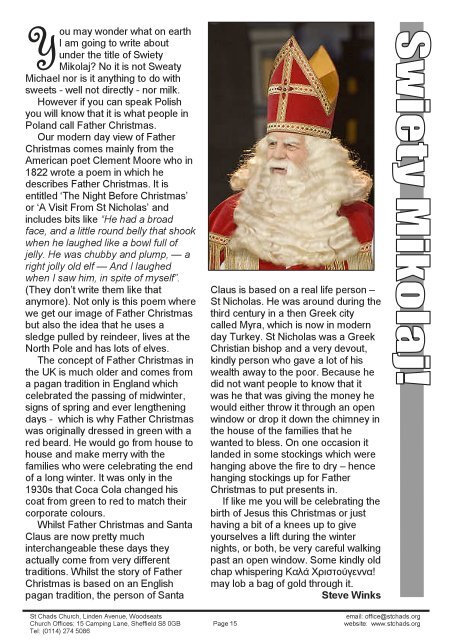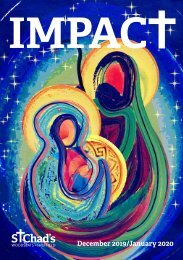You also want an ePaper? Increase the reach of your titles
YUMPU automatically turns print PDFs into web optimized ePapers that Google loves.
Y<br />
ou may wonder what on earth<br />
I am going to write about<br />
under the title of Swiety<br />
Mikolaj? No it is not Sweaty<br />
Michael nor is it anything to do with<br />
sweets - well not directly - nor milk.<br />
However if you can speak Polish<br />
you will know that it is what people in<br />
Poland call Father Christmas.<br />
Our modern day view of Father<br />
Christmas comes mainly from the<br />
American poet Clement Moore who in<br />
1822 wrote a poem in which he<br />
describes Father Christmas. It is<br />
entitled ‘The Night Before Christmas’<br />
or ‘A Visit From St Nicholas’ and<br />
includes bits like “He had a broad<br />
face, and a little round belly that shook<br />
when he laughed like a bowl full of<br />
jelly. He was chubby and plump, — a<br />
right jolly old elf — And I laughed<br />
when I saw him, in spite of myself”.<br />
(They don’t write them like that<br />
anymore). Not only is this poem where<br />
we get our image of Father Christmas<br />
but also the idea that he uses a<br />
sledge pulled by reindeer, lives at the<br />
North Pole and has lots of elves.<br />
The concept of Father Christmas in<br />
the UK is much older and comes from<br />
a pagan tradition in England which<br />
celebrated the passing of midwinter,<br />
signs of spring and ever lengthening<br />
days - which is why Father Christmas<br />
was originally dressed in green with a<br />
red beard. He would go from house to<br />
house and make merry with the<br />
families who were celebrating the end<br />
of a long winter. It was only in the<br />
1930s that Coca Cola changed his<br />
coat from green to red to match their<br />
corporate colours.<br />
Whilst Father Christmas and Santa<br />
Claus are now pretty much<br />
interchangeable these days they<br />
actually come from very different<br />
traditions. Whilst the story of Father<br />
Christmas is based on an English<br />
pagan tradition, the person of Santa<br />
Claus is based on a real life person –<br />
St Nicholas. He was around during the<br />
third century in a then Greek city<br />
called Myra, which is now in modern<br />
day Turkey. St Nicholas was a Greek<br />
Christian bishop and a very devout,<br />
kindly person who gave a lot of his<br />
wealth away to the poor. Because he<br />
did not want people to know that it<br />
was he that was giving the money he<br />
would either throw it through an open<br />
window or drop it down the chimney in<br />
the house of the families that he<br />
wanted to bless. On one occasion it<br />
landed in some stockings which were<br />
hanging above the fire to dry – hence<br />
hanging stockings up for Father<br />
Christmas to put presents in.<br />
If like me you will be celebrating the<br />
birth of Jesus this Christmas or just<br />
having a bit of a knees up to give<br />
yourselves a lift during the winter<br />
nights, or both, be very careful walking<br />
past an open window. Some kindly old<br />
chap whispering Καλά Χριστούγεννα!<br />
may lob a bag of gold through it.<br />
Steve Winks<br />
St Chads Church, Linden Avenue, Woodseats<br />
email: office@stchads.org<br />
Church Offices: 15 Camping Lane, Sheffield S8 0GB Page 15 website: www.stchads.org<br />
Tel: (0114) 274 5086


















